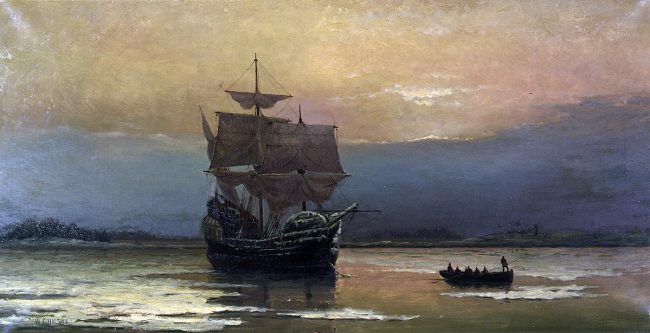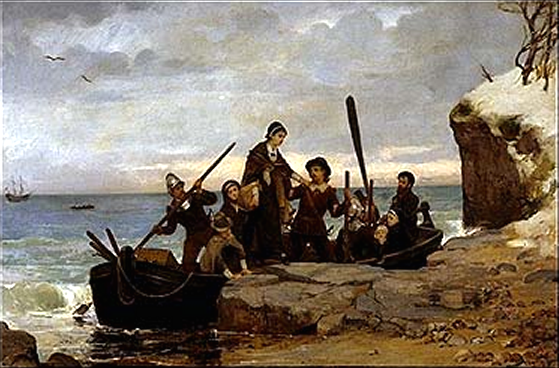
“Mayflower in Plymouth Harbor,” by William Halsall, 1882
On September 16, 1620, the famous transport ship Mayflower started its first voyage to the new world with English and Dutch separatists on board and arriving Plymouth, Massachusetts in the same year. The ship has become a cultural icon in the history of the United States.
Rough Seas and First Winter
On board of the 170 ton Dutch cargo ship were a total of 102 passengers and an additional number of 30 crew members. They all were curious and hopeful to start a new life at the banks of the Hudson River, which would now be New York City. However, during their two month travel the passengers had to deal with rough seas leading to two deaths on board. Also the weather caused them to approach a different destination than originally planned. They anchored near today’s Plymouth in Massachusetts and had to do nothing but wait for the winter to come, and to finally leave. During the winter, all travelers had to remain on the ship, and only half of them could survive the strong winter period. In these appallingly cramped and hygienically catastrophic conditions, pneumonia and tuberculosis decimated the settlers, and among the dead were many children. As soon as it started to warm up, the pilgrims were finally able to leave the ship and began building their new homes, while the fixed ship sailed back to England.
The Pilgrims
A congregation of approximately four hundred English Puritans living in exile in Leiden, Holland, was determined to purge the Church of England of what they felt were many excesses and abuses. But rather than work for change in England, they chose to live as separatists in religiously tolerant Holland in 1608. As separatists, they were considered illegal radicals by their home country of England. However, life in Holland became increasingly difficult for the congregation. Their desire to travel to America was considered audacious and risky, as previous attempts to settle in North America had failed.
The Mayflower
The Mayflower itself was built at some point around 1606, had an overall length of 28 meters (110 ft) and four decks. Christopher Jones and several business partners bought the ship Mayflower around 1607, but the origins before that are uncertain. Its first documented voyage was to Trondheim in Norway in 1609. Andrew Pawling rented the ship to bring a cargo of London goods to Norway, sell them and buy Norwegian goods (wood, tar, fish) to return to England. Unfortunately, the Mayflower encountered a severe North Sea storm on its return journey and the captain and crew were forced to throw most of Pawling’s goods overboard to lighten the ship. After that Christopher Jones seems to have followed safer trade routes. The Mayflower made numerous voyages, particularly to Bordeaux, France, and returned to London with cargoes of French wine, cognac, vinegar and salt. The Mayflower could carry about 180 tons of cargo. The Mayflower also made occasional trips to other ports, including once to Malaga, Spain, and twice to Hamburg, Germany.
Towards the New World
After returning from a trip to Bordeaux, France, in May 1620, the Mayflower and Christopher Jones were hired to take pilgrims to Northern Virginia. This was the first recorded transatlantic voyage for ship and captain, although Christopher Jones had several crew members, including Captain’s comrades John Clarke and Robert Coppin, who had already been to the New World. Since the Mayflower was originally built for the transportation of goods, this made the settlers’ journey to America quite uncomfortable. The passengers had to share the cabins with living animals, lots of tools and several weapons, such as canons, artillery pieces, and huge loads of gunpowder. After the long journey to America and back to England, the Mayflower was strongly damaged and was taken out of order in 1622.

The Landing of the Pilgrims.
The Mayflower Compact
Although the Mayflower did not survive for long, the Separatists were able to manage their living in Plymouth and started their own government in the year of their arrival, which was manifested in the so called ‘Mayflower Compact‘. The settlement of Plymouth counts as one of the oldest in the new world and therefore the Mayflower depicts a symbol of freedom, future, and hope to many Americans. Plymouth was established by English separatist Puritans who had broken away from the Church of England, believing that the Church had not completed the work of the Protestant Reformation. Today, these settlers are much better known as the Pilgrims, a term coined by William Bradford.
Not the oldest British Colony in America
The Mayflower’s journey is the most prominent example of the settlement of America by Europeans and is sometimes misrepresented as its beginning. In fact, however, the colonization of North America in modern times began in the middle of the 16th century with the settlement of Newfoundland, so the city of St. John’s is considered the oldest British colony with the seizure by the English crown in 1583, almost 40 years before the crossing of the Mayflower. Today, many Americans, especially the noble families of New England, try to trace their ancestry back to a passenger on the Mayflower. The “General Society of Mayflower Descendants” was founded in 1897 in Plymouth, Massachusetts.
Joanne B. Freeman, 2. Being a British Colonist, [8]
References and Further Reading:
- [1] The History of the Mayflower Ship at History of Massachusetts
- [2] The Mayflower at Britannica Online
- [3] The Mayflower and her Log, as ebook at Project Gutenberg
- [4] Philbrick, Nathaniel (2006). Mayflower: A Story of Courage, Community, and War. Viking. .
- [5] The Mayflower at Wikidata
- [6] . Encyclopedia Americana. 1920.
- [7] Bradford, William (1908). Davis, William T. (ed.). Bradford’s History of Plymouth Plantation, 1606–1646. Scribners.
- [8] Joanne B. Freeman, 2. Being a British Colonist, The American Revolution (HIST 116), YaleCourses @ youtube





